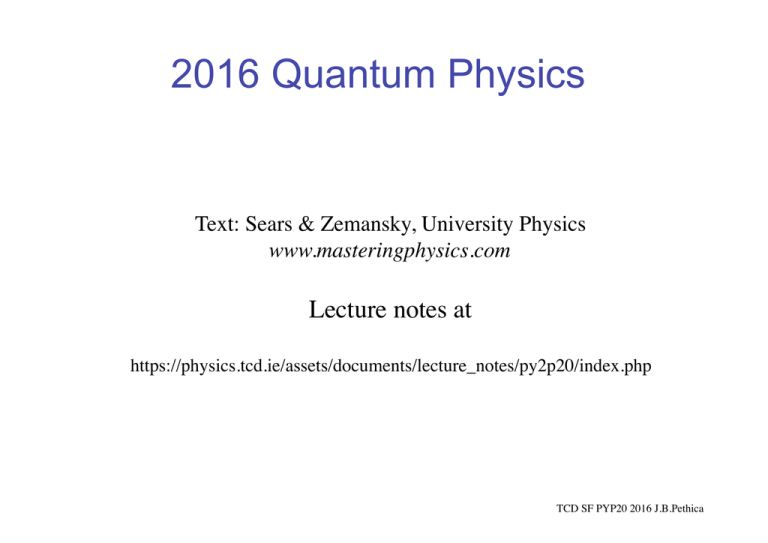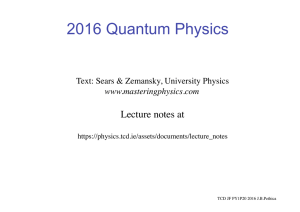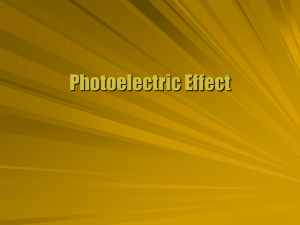Lecture 1
advertisement

2016 Quantum Physics Text: Sears & Zemansky, University Physics www.masteringphysics.com Lecture notes at https://physics.tcd.ie/assets/documents/lecture_notes/py2p20/index.php TCD SF PYP20 2016 J.B.Pethica Lecture 1 Summary: Classical concepts: Particle mechanics, Electromagnetism, Waves, Diffraction, Relativity, Thermodynamics Quantum phenomena The Photoelectric effect Particle properties of photons CLASSICAL CONCEPTS (i.e. things you already know) Particle Mechanics Newton’s Laws of motion Momentum p = mv x = A cos ωt 1 2 Kinetic energy E = mv 2 Conservation of momentum, and of energy in elastic collisions Simple Harmonic motion: Restoring force F= -µx ~ 1900 Energy in oscillation = Charged Particles Forces on charges F = e( E + v × B) (Lorenz force - vector) Force is in direction of electric field E, plus at right angles to the plane of velocity v and magnetic field B (so B does not change v or KE) Electric potential V E = - dV/dx e.g. Potential due to point charge e −e U= 4πε r Waves Frequency f (or ν) Wavelength λ Angular frequency Group velocity ω = 2πf dω u= dk ω Phase velocity v = fλ = k 2π Wavenumber k = v a function of ω , k λ (Dispersive waves) Plane Waves φ = Aexpi( kx − ω t ) Intensity (energy) ∝ A2 Amplitude A Diffraction Maxima for path difference = nλ d sin θ = nλ d θ 2d sin θ = nλ n = 0,1,2,3,...... θ d Normal incidence on plane apertures Scattering from multiple planes of atoms (Bragg) Relativity E = mc ‘rest’ mass m0 And S&Z Ch. 37.7, 37.8 2 m = γ m0 = m0 1 − v 2 c2 E = p c +m c 2 2 2 2 4 0 Thermal properties S&Z Ch. 18.4 Equipartition of energy - kBT/2 per degree of freedom (mode) e.g. 1-D oscillator - kBT (1/2 P.E. 1/2 K.E.) Free particle in 3-D – 3kBT/2 Oscillator in 3-D - 3kBT QUANTUM PHENOMENA Classical physics has problems explaining some experiments…. The distinction between classical concepts is blurred in many important experiments. Phenomena may not be regarded as strictly wave-like or particle-like. Key observations are: Photo-electric effect, Compton effect, specific heats, black-body radiation, atomic spectra, electron diffraction…. Solving these led to a revolution in thinking: photons, wave-particle duality, uncertainty principle & more…. A. Piccard, E. Henriot, P. Ehrenfest, E. Herzen, Th. de Donder, E. Schrödinger, J.E. Verschaffelt, W. Pauli, W. Heisenberg, R.H. Fowler, L. Brillouin; P. Debye, M. Knudsen, W.L. Bragg, H.A. Kramers, P.A.M. Dirac, A.H. Compton, L. de Broglie, M. Born, N. Bohr; I. Langmuir, M. Planck, M. Skłodowska-Curie, H.A. Lorentz, A. Einstein, P. Langevin, Ch.-E. Guye, C.T.R. Wilson, O.W. Richardson 1927 Solvay conference The Photoelectric Effect Evacuated tube, 2 electrodes E: emitter, C: collector Light incident on E, electrons are emitted & travel to C Current I in external circuit depends on V Note: polarity of V impedes arrival of photo-electrons: “retarding or stopping potential” The Photoelectric Effect: what is observed (1) I-V dependence (for a single frequency of light) V = Vo gives I = 0 the “stopping potential” implies a range of electron kinetic energies from 0 to KEmax, where KEmax = eVo (2) linear dependence of I on light intensity, BUT Vo is unchanged by intensity i.e. intensity of light affects number of but not energies of electrons (3) no time delay (“instant” emission) (4) AND…. An important light frequency dependence…... The frequency dependence Vo depends linearly on f Write Vo ∝ (f - fo) Note: cut-off frequency (fo) below which there is no current All these observations are incompatible with Classical Physics… Electrons in the emitter Electrons in metal – held in a potential ‘well’ Highest lying electrons at energy depth φ known as “work function” φ Classical view: electrons accumulate energy from incident light waves! Therefore KE should increase with light intensity cf (1) + (2) Also, should see time lag at low intensity cf (3) Should be no minimum frequency cf (4) To solve this PROBLEM, Einstein (1905) borrows from Planck….. Einstein model of photoelectric effect Light is not waves but energy “packets” (later “photons”) each photon has energy hf = ω Planck’s constant h hf KEmax Photoelectron is ejected (instantly) through the complete absorption of one photon. hf = KE + (depth in well) Consider the highest-lying electrons hf = KEmax + φ KEmax = hf – φ (recall: KEmax = eVo) eVo = hf - φ Vo = (h/e) f - (φ/e) = (h/e)(f - f o) φ hf hν “Despite then the apparently complete success of the Einstein equation, the physical theory of which it was designed to be the symbolic expression is found so untenable that Einstein himself, I believe, no longer holds to it……” (Millikan) Summary – photoelectric effect (using ω for frequency, = h/2π ) Observe: 1. Electrons only emitted for ω > ω0 2. Intensity of light affects the number of electrons but NOT their energy 3. Emitted electron max. KE = (ω − ω 0 ) Conclude: a) Photon energy E = ω b) Work Function φ = ω 0 is the energy required to extract an electron from the metal. Particle Properties of Photons Photons: (1) energy E = ω (2) travel at speed of light c - relativistic treatment? E = mc 2 = m0 c 2 1− v c 2 v = c ⇒ E = ∞? 2 Photon must have zero rest mass! What about momentum? E = m c + p c =0+ p c 2 2 4 0 E = pc = ω 2 2 2 2 ω h p= = k = c λ Photon has momentum related to wavelength! - collisions?

